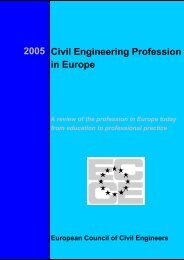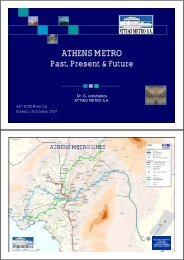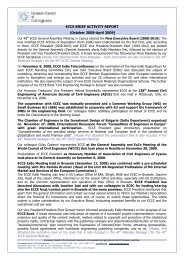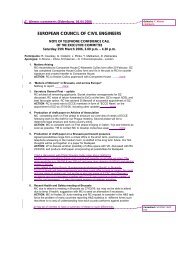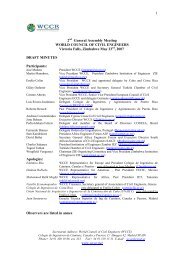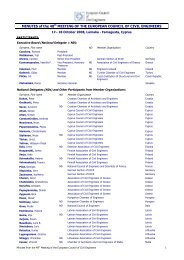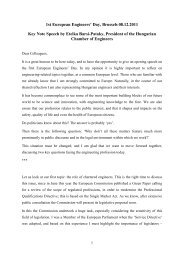A Closer Look at Prevailing Civil Engineering Practice - European ...
A Closer Look at Prevailing Civil Engineering Practice - European ...
A Closer Look at Prevailing Civil Engineering Practice - European ...
You also want an ePaper? Increase the reach of your titles
YUMPU automatically turns print PDFs into web optimized ePapers that Google loves.
A <strong>Closer</strong> <strong>Look</strong> <strong>at</strong> <strong>Prevailing</strong> <strong>Civil</strong> <strong>Engineering</strong> <strong>Practice</strong>, Wh<strong>at</strong>, Why and How<br />
Vincent T. H. CHU<br />
10. Wh<strong>at</strong> are the causes of longitudinal cracks and transverse cracks<br />
in bituminous pavement<br />
Longitudinal cracks in bituminous pavement are usually caused by f<strong>at</strong>igue<br />
failure under repe<strong>at</strong>ed traffic loading. In thin pavements, cracking starts <strong>at</strong><br />
the bottom of the bituminous layer where the tensile stress is the highest<br />
and then it spreads to the surface as one or more longitudinal cracks. In<br />
thick pavements, the cracks usually commence from the top because of<br />
high localized tensile stresses from tire-pavement interaction. After<br />
repe<strong>at</strong>ed loading, the longitudinal cracks develop into a p<strong>at</strong>tern similar to<br />
the back of an allig<strong>at</strong>or.<br />
Transverse cracks are usually formed as a result of thermal movement. It<br />
may occur because of shrinkage of the bituminous surface due to low<br />
temper<strong>at</strong>ures or asphalt binder hardening.<br />
11. Which of the following cause much damage to bituminous<br />
pavement<br />
(a) Low usage by heavy vehicles or frequent usage of light<br />
vehicles;<br />
(b) Low speed traffic or high speed traffic<br />
The rel<strong>at</strong>ionship between axle weight and the associ<strong>at</strong>ed pavement<br />
damage is not linear but exponential. The pavement damage caused by<br />
one passage of a fully loaded tractor-semi trailer (80kN) is more than 3,000<br />
passages of priv<strong>at</strong>e cars (9KN). Hence, heavy trucks and buses are<br />
responsible for a majority of pavement damage.<br />
Slow-moving traffic imposes gre<strong>at</strong>er damage than fast-moving traffic. Past<br />
studies showed th<strong>at</strong> when the speed is increased from 2km/hr to 24km/hr,<br />
the stress and pavement deflection is reduced by 40%.<br />
12. Wh<strong>at</strong> are the differences between tensioned corrug<strong>at</strong>ed beam and<br />
untensioned corrug<strong>at</strong>ed beam<br />
Tensioned corrug<strong>at</strong>ed beam is mainly used in high speed road while<br />
untensioned corrug<strong>at</strong>ed beam is mainly used in low speed road.<br />
Tensioned corrug<strong>at</strong>ed beam is designed mainly for use on central<br />
reserv<strong>at</strong>ion. When a vehicle crashes into tensioned corrug<strong>at</strong>ed beam, the<br />
beam remains in tension while the post gives way to allow for deform<strong>at</strong>ion.<br />
Tensioned corrug<strong>at</strong>ed beam absorbs impact energy by deflecting as a<br />
47




